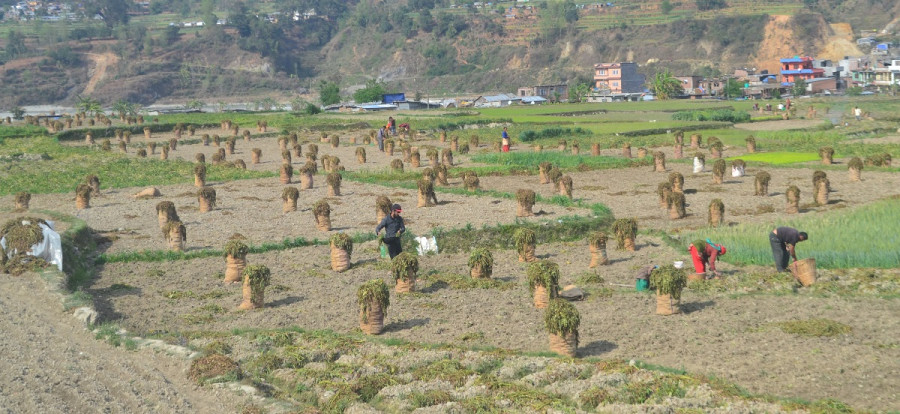Money
Potato farmers all smiles because of steady prices and strong demand
Sindhupalchok district produces 65,750 tonnes of potatoes annually, according to the agriculture office.
Anish Tiwari
Farmer Keshav Thapa of Balephi Rural Municipality, Phulpingkot, sold his potato harvest at Rs27 per kg this year. He is happy to see traders visiting farmers to buy their potato crops, the third most important food crop after rice and wheat, and a staple for 1.3 billion people across the globe.
"It’s potato harvesting time and everyone is busy,” Thapa said. Normally, at this time of the year, potato prices fall to their lowest due to a post-harvest glut in supply. But farmers said that demand increased after the lockdown last March, and the vegetable continues to be sought after this year too.
During the virus lockdown, fresh potatoes became a favourite for all because they were inexpensive and easily available.
“I earned Rs100,000 from my potato crop this year,” said Thapa. “The income from potatoes is good. That’s why everyone is growing them. Production has also swelled, and everyone in the village made a lot of money.”
Kavita Majhi, 54, sold her potatoes at Sipaghat bazaar which lies on the border between Kabhre and Melamchi municipalities. She is not worried as her harvest has increased this year.
“We have seen hordes of traders from Melamchi, Dhulikhel, Banepa and even Kathmandu coming to the farmers' fields to buy potatoes,” she said. "Demand for potatoes lasts year-round.”
According to Majhi, the potatoes produced in Balephi Rural Municipality always get their value due to the quality, and it’s not difficult to sell them in the market.
The potatoes grown in Mude, Sindhupalchok district are sold under the brand name Mude’s Quality Potato. In 2016, the District Agricultural Office of Sindhupalchok granted the label to the district’s most famous product as part of its branding exercise.
Apart from Mude, the potatoes are widely and commercially grown in different parts of Sindhupalchok and neighbouring Dolakha district.
Farmers cultivate potatoes at all times of the year—in the summer, rainy and winter seasons—and in the hills and mountains.
In mid-February, the peak harvest season, all farmers can be seen working busily in their fields digging out the potatoes from the ground.
The banks of the Bramhayani, Indrawati, Melamchi and Jyadikhola rivers are a scene of hectic activity with farmers and traders gathering potatoes and packing them into sacks.
The Bramhayani corridor is emerging as a commercial potato producing area.
According to the statistics of the agriculture office, three municipalities and nine rural municipalities in Sindhupalchok produce a combined 65,750 tonnes of potatoes annually. The summer and winter harvest are valued at about Rs600 million annually.
"In the summer, which is also the rainy season, farmers grow potatoes worth Rs160 million. The winter potato harvest in Sindhupalchok is valued at Rs424.24 million," said Durgadatta Panthi, an agriculture extension officer at the Agriculture Knowledge Centre, formerly the District Agriculture Development Office.
About 80 percent of the farmers are engaged in growing potatoes, and the potato acreage is about 10,000 hectares, Panthi said.
The number of farmers engaged in commercial potatoes farming has been increasing due to various support programmes, he said.
Traders appear at the farmers' homes with trucks to load potatoes, and even make advance payment, in potato growing areas like Bramhayani, Melamchi, Indrawati, Mude, Jugal Gapa, Helambu and Panchpokhari.
Traders said that summer and winter potatoes have different values and importance.
Potatoes produced in the winter season, particularly the famous Mude potatoes, fetch an average price of Rs60 per kg in the market, more than double the rate of other brands.
In the summer, the district produces 15,247 tonnes of potatoes, out of which 7,624 tonnes are shipped to the Kathmandu Valley, said Panthi.
The winter potato harvest amounts to 50,503 tonnes, and 35,352 tonnes are dispatched to the Kathmandu Valley, he said. “This shows that winter potatoes, which are considered a quality crop, are in greater demand in Kathmandu.”
Potato is a staple crop in the high hills of Nepal. It is one of the important crops for addressing food insecurity in the country. Nepal produced 3.11 million tonnes of potato in 2018-19, according to the figures of the Ministry of Agriculture and Livestock Development.
Import trends show that the country’s output falls short of the requirement. According to agro experts, Nepal was self-sufficient in potato production until a few years ago, but imports have been swelling of late.
Nepal bought foreign potatoes worth Rs6.32 billion in fiscal 2019-20, as per the statistics of the Customs Department.




 17.12°C Kathmandu
17.12°C Kathmandu














